
Giant Plumose Anemones cover underwater reef, Browning Pass, northern Vancouver Island, Canada.
Species: Giant plumose anemone, Metridium farcimen
Location: British Columbia, Canada
Image ID: 34428
Species: Giant plumose anemone, Metridium farcimen
Location: British Columbia, Canada
Image ID: 34428
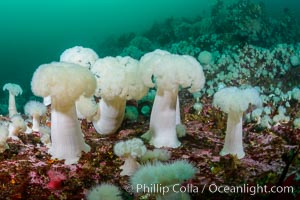
Giant Plumose Anemones cover underwater reef, Browning Pass, northern Vancouver Island, Canada.
Species: Giant plumose anemone, Metridium farcimen
Location: British Columbia, Canada
Image ID: 34433
Species: Giant plumose anemone, Metridium farcimen
Location: British Columbia, Canada
Image ID: 34433

Giant Plumose Anemones cover underwater reef, Browning Pass, northern Vancouver Island, Canada.
Species: Giant plumose anemone, Metridium farcimen
Location: British Columbia, Canada
Image ID: 34442
Species: Giant plumose anemone, Metridium farcimen
Location: British Columbia, Canada
Image ID: 34442

Giant Plumose Anemones cover underwater reef, Browning Pass, northern Vancouver Island, Canada.
Species: Giant plumose anemone, Metridium farcimen
Location: British Columbia, Canada
Image ID: 34443
Species: Giant plumose anemone, Metridium farcimen
Location: British Columbia, Canada
Image ID: 34443

Giant Plumose Anemones cover underwater reef, Browning Pass, northern Vancouver Island, Canada.
Species: Giant plumose anemone, Metridium farcimen
Location: British Columbia, Canada
Image ID: 34446
Species: Giant plumose anemone, Metridium farcimen
Location: British Columbia, Canada
Image ID: 34446

Giant Plumose Anemones cover underwater reef, Browning Pass, northern Vancouver Island, Canada.
Species: Giant plumose anemone, Metridium farcimen
Location: British Columbia, Canada
Image ID: 34447
Species: Giant plumose anemone, Metridium farcimen
Location: British Columbia, Canada
Image ID: 34447

Red Irish Lord fin detail, Browning Pass, British Columbia.
Species: Red irish lord, Hemilepidotus hemilepidotus
Location: British Columbia, Canada
Image ID: 35445
Species: Red irish lord, Hemilepidotus hemilepidotus
Location: British Columbia, Canada
Image ID: 35445

Red Irish Lord eye detail, Browning Pass, British Columbia.
Species: Red irish lord, Hemilepidotus hemilepidotus
Location: British Columbia, Canada
Image ID: 35448
Species: Red irish lord, Hemilepidotus hemilepidotus
Location: British Columbia, Canada
Image ID: 35448
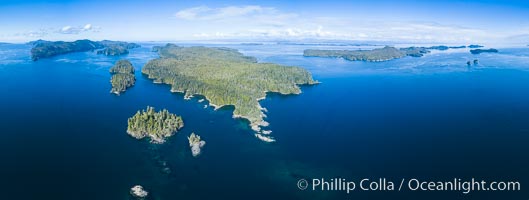
Balaklava Island and Browning Pass, location of the best cold water diving in the world, aerial photo.
Location: British Columbia, Canada
Image ID: 34485
Panorama dimensions: 4570 x 12090
Location: British Columbia, Canada
Image ID: 34485
Panorama dimensions: 4570 x 12090

Hurst Island, Balaklava Island (left) and Gods Pocket Provincial Park, aerial photo.
Location: Gods Pocket Provincial Park, Vancouver Island, British Columbia, Canada
Image ID: 34488
Location: Gods Pocket Provincial Park, Vancouver Island, British Columbia, Canada
Image ID: 34488

Devil's Postpile, a spectacular example of columnar basalt. Once molten and under great pressure underground, the lava that makes up Devil's Postpile cooled evenly and slowly, contracting and fracturing into polygonal-sided columns. The age of the formation is estimated between 100 and 700 thousand years old. Sometime after the basalt columns formed, a glacier passed over the formation, cutting and polishing the tops of the columns. The columns have from three to seven sides, varying because of differences in how quickly portions of the lava cooled.
Location: Devils Postpile National Monument, California
Image ID: 23281
Location: Devils Postpile National Monument, California
Image ID: 23281

Devil's Postpile, a spectacular example of columnar basalt. Once molten and under great pressure underground, the lava that makes up Devil's Postpile cooled evenly and slowly, contracting and fracturing into polygonal-sided columns. The age of the formation is estimated between 100 and 700 thousand years old. Sometime after the basalt columns formed, a glacier passed over the formation, cutting and polishing the tops of the columns. The columns have from three to seven sides, varying because of differences in how quickly portions of the lava cooled.
Location: Devils Postpile National Monument, California
Image ID: 23282
Location: Devils Postpile National Monument, California
Image ID: 23282

Devil's Postpile, a spectacular example of columnar basalt. Once molten and under great pressure underground, the lava that makes up Devil's Postpile cooled evenly and slowly, contracting and fracturing into polygonal-sided columns. The age of the formation is estimated between 100 and 700 thousand years old. Sometime after the basalt columns formed, a glacier passed over the formation, cutting and polishing the tops of the columns. The columns have from three to seven sides, varying because of differences in how quickly portions of the lava cooled.
Location: Devils Postpile National Monument, California
Image ID: 23283
Location: Devils Postpile National Monument, California
Image ID: 23283

Devil's Postpile, a spectacular example of columnar basalt. Once molten and under great pressure underground, the lava that makes up Devil's Postpile cooled evenly and slowly, contracting and fracturing into polygonal-sided columns. The age of the formation is estimated between 100 and 700 thousand years old. Sometime after the basalt columns formed, a glacier passed over the formation, cutting and polishing the tops of the columns. The columns have from three to seven sides, varying because of differences in how quickly portions of the lava cooled.
Location: Devils Postpile National Monument, California
Image ID: 23284
Location: Devils Postpile National Monument, California
Image ID: 23284
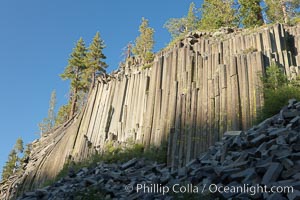
Devil's Postpile, a spectacular example of columnar basalt. Once molten and under great pressure underground, the lava that makes up Devil's Postpile cooled evenly and slowly, contracting and fracturing into polygonal-sided columns. The age of the formation is estimated between 100 and 700 thousand years old. Sometime after the basalt columns formed, a glacier passed over the formation, cutting and polishing the tops of the columns. The columns have from three to seven sides, varying because of differences in how quickly portions of the lava cooled.
Location: Devils Postpile National Monument, California
Image ID: 23286
Location: Devils Postpile National Monument, California
Image ID: 23286
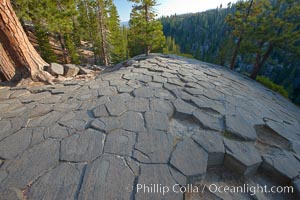
Devil's Postpile, a spectacular example of columnar basalt. Once molten and under great pressure underground, the lava that makes up Devil's Postpile cooled evenly and slowly, contracting and fracturing into polygonal-sided columns. The age of the formation is estimated between 100 and 700 thousand years old. Sometime after the basalt columns formed, a glacier passed over the formation, cutting and polishing the tops of the columns. The columns have from three to seven sides, varying because of differences in how quickly portions of the lava cooled.
Location: Devils Postpile National Monument, California
Image ID: 23287
Location: Devils Postpile National Monument, California
Image ID: 23287

Volcanic debris, small lava rocks scattered about the Eureka Valley.
Location: Eureka Valley, Death Valley National Park, California
Image ID: 25340
Location: Eureka Valley, Death Valley National Park, California
Image ID: 25340
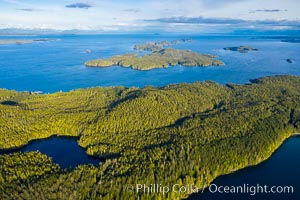
Balaklava Island and Hurst Island, aerial view, Canada.
Location: British Columbia, Canada
Image ID: 35540
Location: British Columbia, Canada
Image ID: 35540

Paulet Island, near the Antarctic Peninsula, is a cinder cone flanks by lava flows on which thousands of Adelie Penguins nest.
Location: Paulet Island, Antarctic Peninsula, Antarctica
Image ID: 26358
Location: Paulet Island, Antarctic Peninsula, Antarctica
Image ID: 26358

Paulet Island, near the Antarctic Peninsula, is a cinder cone flanks by lava flows on which thousands of Adelie Penguins nest.
Location: Paulet Island, Antarctic Peninsula, Antarctica
Image ID: 26359
Location: Paulet Island, Antarctic Peninsula, Antarctica
Image ID: 26359

Paulet Island, near the Antarctic Peninsula, is a cinder cone flanks by lava flows on which thousands of Adelie Penguins nest.
Location: Paulet Island, Antarctic Peninsula, Antarctica
Image ID: 24824
Location: Paulet Island, Antarctic Peninsula, Antarctica
Image ID: 24824

Paulet Island, near the Antarctic Peninsula, is a cinder cone flanks by lava flows on which thousands of Adelie Penguins nest.
Location: Paulet Island, Antarctic Peninsula, Antarctica
Image ID: 26361
Location: Paulet Island, Antarctic Peninsula, Antarctica
Image ID: 26361

Lava formations, Guadalupe Island, Mexico.
Location: Guadalupe Island (Isla Guadalupe), Baja California, Mexico
Image ID: 36139
Location: Guadalupe Island (Isla Guadalupe), Baja California, Mexico
Image ID: 36139

Paulet Island, near the Antarctic Peninsula, is a cinder cone flanks by lava flows on which thousands of Adelie Penguins nest.
Location: Paulet Island, Antarctic Peninsula, Antarctica
Image ID: 24891
Location: Paulet Island, Antarctic Peninsula, Antarctica
Image ID: 24891

Marine iguana, underwater, forages for green algae that grows on the lava reef.
Species: Marine iguana, Amblyrhynchus cristatus
Location: Bartolome Island, Galapagos Islands, Ecuador
Image ID: 16228
Species: Marine iguana, Amblyrhynchus cristatus
Location: Bartolome Island, Galapagos Islands, Ecuador
Image ID: 16228

Encrusting sponges cover the lava reef.
Location: Cousins, Galapagos Islands, Ecuador
Image ID: 16456
Location: Cousins, Galapagos Islands, Ecuador
Image ID: 16456

Lava lizard, Punta Espinosa.
Species: Lava lizard, Tropidurus
Location: Fernandina Island, Galapagos Islands, Ecuador
Image ID: 01748
Species: Lava lizard, Tropidurus
Location: Fernandina Island, Galapagos Islands, Ecuador
Image ID: 01748

Cactus and lava field, Punta Espinosa.
Location: Fernandina Island, Galapagos Islands, Ecuador
Image ID: 05585
Location: Fernandina Island, Galapagos Islands, Ecuador
Image ID: 05585

Undine Falls, between Mammoth and Tower in Yellowstone National Park, marks where Lava Creek drops 110 feet in two sections.
Location: Yellowstone National Park, Wyoming
Image ID: 13304
Location: Yellowstone National Park, Wyoming
Image ID: 13304
